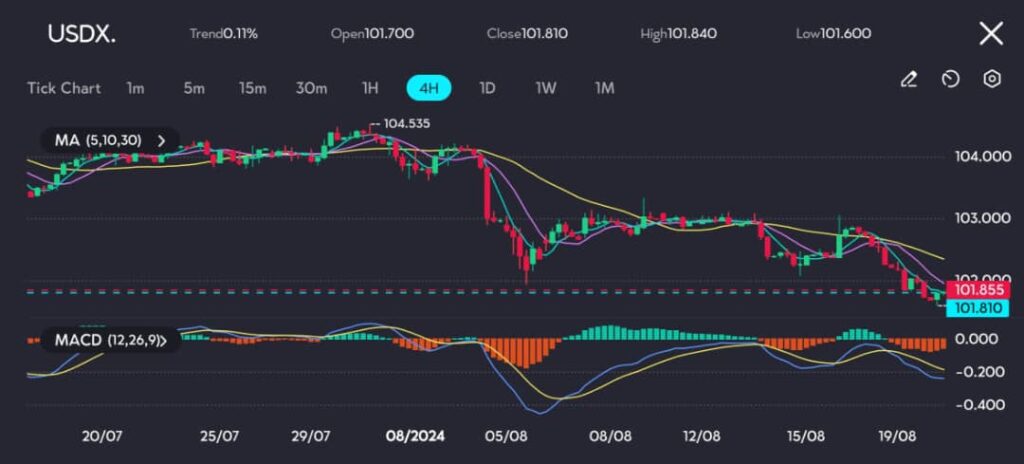Key points:
- The U.S. dollar remains near a seven-month low as expectations for interest rate cuts grow.
- Traders await Fed Chair Jerome Powell’s speech at Jackson Hole for potential insights into future rate cuts.
On Tuesday, the U.S. dollar hovered near its lowest point in seven months, driven by increasing expectations that the Federal Reserve may begin cutting interest rates as soon as next month.
The anticipation of potential monetary easing has influenced the broader currency markets, lifting the euro and other major currencies against the dollar.
Euro and British pound surge to new highs, marking strong monthly gains
The euro rose to its highest level of the year, with EUR/USD reaching $1.1080, after briefly touching $1.108775 earlier in the session. This marks a 2.4% increase in the euro for the month, positioning it for its strongest monthly performance since November.
Similarly, the British pound traded near a one-month peak at $1.2985, maintaining strength after reaching $1.2998 in the previous session.
The Japanese yen showed slight gains, trading at 146.50 per dollar, close to the near two-week high achieved in the previous session. However, it remains some distance from the seven-month high of 141.675 touched at the beginning of August.
All eyes on Powell’s Jackson Hole speech for interest rate clues
Market participants are focusing on Federal Reserve Chair Jerome Powell’s upcoming speech at the Jackson Hole Economic Symposium later this week. Investors are closely watching for any signals regarding the Fed’s plans for interest rates, particularly whether it will opt for a 25-basis-point (bps) or a 50-bps cut in September.
The market currently sees a 24.5% chance of a 50-bps rate cut in September, down from 50% a week ago. A 25-bps cut is now viewed as more likely, with a 75.5% probability. Overall, traders are pricing in 93 bps of cuts for the entire year.
You might be interested: Markets test ground before Symposium
Dollar index hits lowest level since January, extending monthly decline
The dollar index (DXY), which measures the dollar’s strength against six major rivals, fell to 101.82 on Tuesday, its lowest level since January 2. The index has dropped more than 2% in August, indicating a second consecutive month of decline.

Picture: Dollar index trading at 101.855 on the VT Markets app.
Looking at the charts, we see the USDX reflecting the ongoing uncertainty surrounding the U.S. dollar as market participants weigh the likelihood of Federal Reserve rate cuts. The dollar index has been trading around the 101.810 level, which marks a continuation of the recent downtrend that began in early August.
Moving Averages (MAs) are sloping downward, particularly the short-term MAs (5, 10, 30), indicating bearish momentum. The MACD indicator also shows the MACD line below the signal line, reinforcing the negative sentiment.
The broader U.S. economic landscape suggests that the scope for aggressive rate cuts may be limited. Solid domestic demand and signs of moderate disinflation imply that the Federal Reserve might adopt a more cautious approach to easing monetary policy. This could lead to a reassessment of market expectations, potentially slowing the pace of the dollar’s decline.
If the economic data continues to support this view, we might see the dollar stabilising or even recovering as market participants adjust their expectations.
Key levels to watch include the support around 101.600, which, if breached, could signal further downside. On the upside, resistance near the 102.000 mark might provide a cap unless there’s a major shift in market sentiment or economic conditions.
Markets decline down under
Elsewhere, the Australian dollar (AUD/USD) has declined by 0.12% to $0.6725, while the New Zealand dollar (NZD/USD) remained steady at $0.61135, showing varied reactions among different currencies.
Investors will also be closely monitoring the release of the minutes from the Fed’s last meeting, scheduled for Wednesday. These minutes are expected to provide additional insights into the central bank’s current thinking and could further influence market expectations ahead of Powell’s speech.
Start trading now — click here to create your live VT Markets account.









